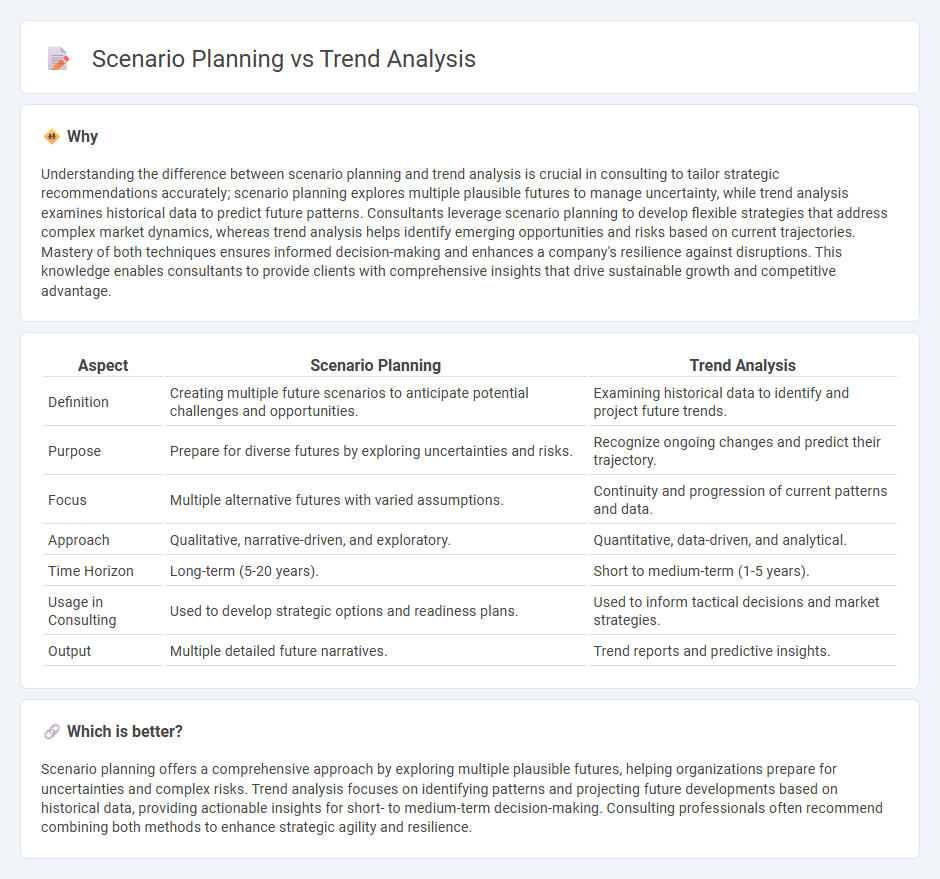
Scenario planning explores multiple potential futures by examining uncertainties and developing strategic responses, while trend analysis focuses on identifying and forecasting patterns based on current data and historical developments. Both methods provide critical insights for informed decision-making in consulting, with scenario planning offering flexibility and adaptability, and trend analysis delivering evidence-based predictions. Discover which approach best suits your business strategy needs.
Why it is important
Understanding the difference between scenario planning and trend analysis is crucial in consulting to tailor strategic recommendations accurately; scenario planning explores multiple plausible futures to manage uncertainty, while trend analysis examines historical data to predict future patterns. Consultants leverage scenario planning to develop flexible strategies that address complex market dynamics, whereas trend analysis helps identify emerging opportunities and risks based on current trajectories. Mastery of both techniques ensures informed decision-making and enhances a company's resilience against disruptions. This knowledge enables consultants to provide clients with comprehensive insights that drive sustainable growth and competitive advantage.
Comparison Table
| Aspect | Scenario Planning | Trend Analysis |
|---|---|---|
| Definition | Creating multiple future scenarios to anticipate potential challenges and opportunities. | Examining historical data to identify and project future trends. |
| Purpose | Prepare for diverse futures by exploring uncertainties and risks. | Recognize ongoing changes and predict their trajectory. |
| Focus | Multiple alternative futures with varied assumptions. | Continuity and progression of current patterns and data. |
| Approach | Qualitative, narrative-driven, and exploratory. | Quantitative, data-driven, and analytical. |
| Time Horizon | Long-term (5-20 years). | Short to medium-term (1-5 years). |
| Usage in Consulting | Used to develop strategic options and readiness plans. | Used to inform tactical decisions and market strategies. |
| Output | Multiple detailed future narratives. | Trend reports and predictive insights. |
Which is better?
Scenario planning offers a comprehensive approach by exploring multiple plausible futures, helping organizations prepare for uncertainties and complex risks. Trend analysis focuses on identifying patterns and projecting future developments based on historical data, providing actionable insights for short- to medium-term decision-making. Consulting professionals often recommend combining both methods to enhance strategic agility and resilience.
Connection
Scenario planning and trend analysis are interconnected tools in consulting that help businesses anticipate future market conditions by evaluating current and emerging trends. Trend analysis identifies patterns and shifts in consumer behavior, technology, and industry dynamics, which scenario planning uses to construct plausible future scenarios. This connection enables consultants to develop strategic recommendations that are resilient against multiple potential futures.
Key Terms
Historical Data (Trend Analysis)
Trend analysis leverages extensive historical data sets to identify consistent patterns and predict future developments by examining past performance metrics, market fluctuations, and consumer behaviors. This method provides a quantitative foundation for forecasting, enabling businesses to make data-driven decisions based on statistical trends and correlations within time-series data. Explore further to understand how these analytical techniques can enhance strategic planning and risk management.
Alternative Futures (Scenario Planning)
Alternative Futures in scenario planning explore multiple plausible outcomes by examining uncertainties and driving forces affecting future developments, unlike trend analysis, which extrapolates current patterns to predict a single likely future. Scenario planning facilitates strategic flexibility and resilience by considering divergent scenarios, improving decision-making under complexity and ambiguity. Discover how adopting Alternative Futures can enhance your organization's foresight and adaptability in an unpredictable world.
Strategic Decision-making
Trend analysis involves examining historical data and patterns to predict future outcomes, helping organizations anticipate market shifts and customer behavior. Scenario planning creates multiple plausible futures, allowing decision-makers to evaluate the impact of different strategic choices under various conditions. Discover how integrating these methods can enhance your strategic decision-making process.
Source and External Links
What is Trend Analysis? Definition, Examples and Methods - Trend analysis is a strategy to make future predictions based on historical data by comparing data points over time, using methods like descriptive, comparative, predictive, and technical analysis, and applying the insights to improve business strategies.
What Is Trend Analysis? Types & Best Practices - NetSuite - Trend analysis is a statistical approach that identifies data patterns over time to forecast future business changes, commonly employing techniques such as time-series and regression analysis to guide strategic decisions.
Trend Analysis: Definitions, Types of Trends and FAQs | Indeed.com - Trend analysis involves using financial statements to spot market patterns and predict future performance by plotting data to detect uptrends, downtrends, and horizontal trends, aiding business and investment decisions.
 dowidth.com
dowidth.com